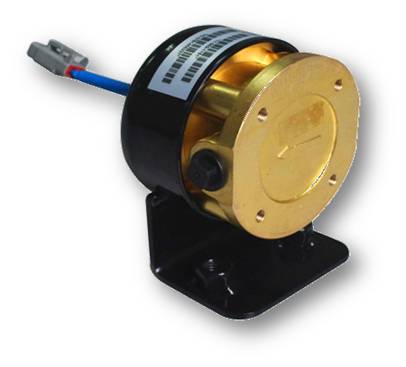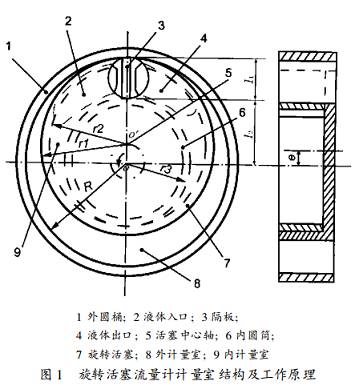Rotary piston flowmeter is a positive displacement flowmeter. The isolation and sealing problem of the inlet and outlet chambers of the measuring chamber is an important link to ensure the accuracy and stability of the measurement. The seal is formed by the contact between the rotating piston and the inner and outer cylinders and the diaphragm. The top surface notch profile design for the piston that contacts the diaphragm is particularly critical. When working, the profile must ensure that the piston presses correctly. The trajectory movement is not interfered, and it is necessary to ensure that the contour of the notch remains in contact with the partition, so that the entry and exit of the cavity are isolated, and a reliable seal is formed.

The structure and working principle of the measuring chamber of the rotary piston flowmeter

As shown in Figure 1, there is a piston 7 on the top surface that can accommodate the gap of the partition when moving. It is located in the annular area formed by the inner wall of the outer cylinder 1 and the outer wall of the inner cylinder 6. The inner and outer walls of the piston are respectively connected to the inner and outer cylinders. The outer and inner walls of the piston are in contact with each other, so that the piston center o'has an offset e from the center o of the inner and outer cylinders. It is not difficult to see that the outer and inner radii of the rotating piston are r 1, r 2, and the inner and outer radii of the outer and inner cylinders R, r 3 Have the following relationships:
Piston wall thickness δ= r 1- r 2 Offset e= R-r 1 Piston outer radius r 1= (R + r 3+ δ) / 2 A radial partition between the inner and outer cylinders separates the annular zone.
The radial dimension of the annular zone I = R-r 3 The length l 1 of the partition within R is slightly larger than the thickness of l partition is the distance between b partition and point o l 2 = R-l 1
In this way, the annular zone is divided into two crescent-shaped inner and outer chamber measuring chambers by the piston wall and the diaphragm. Under the action of the inlet liquid pressure, the piston center o'rotates counterclockwise along the arrow along the o'clock, and the rest of the piston swings in the annular zone. , Its inner and outer cylindrical surfaces are in contact with the inner and outer cylinders in sequence, and the metering cavity continuously moves in a circle to convey fluid. The piston center o'rotates once around o, the inner and outer metering chambers rotate once at the same time, and each liquid is delivered and discharged once. The volume of the crescent-shaped inner and outer metering chambers is the volume flow of the liquid delivered and discharged after one revolution of the piston center. It is a measurable constant:

Among them, h—the height of the measuring room
According to the number of revolutions of the piston n, the amount of liquid flowing through at the number of revolutions can be measured:

Analysis on the Sealing Problem of the Metering Chamber
1. Sealing principle
From the above analysis of the structure and working principle of the flowmeter, it can be seen that when the piston is working, the outer circular surface of the piston, the inner circular surface of the outer cylinder and their mutual contact, the diaphragm and the upper and lower surfaces of the cylinder constitute an outer measuring chamber; and the inner circular surface of the piston, The outer surface of the inner cylinder and its contact with each other, the partition board and the upper and lower surfaces of the cylinder form an inner metering chamber. When the piston is moving, it is required that the top surface of the piston is in contact with the partition to ensure that the movement is not interfered. More importantly, the profile of the notch must always be in contact with the near-center k of the partition to ensure internal measurement. The sealing of the chamber; otherwise, the liquid input from the inlet under pressure will not be transported through the metering chamber, but will directly enter the outlet through the gap and flow out, which may lead to inaccurate metering, and at worst, the flowmeter will not work.
2. Analysis and design calculation of the notch profile equation on the top surface of the piston
1) As shown in Figure 2, when the rotary piston is working, its center o'rotates counterclockwise around o, and the angle between the oo' line and the initial position is set to α, and α is used as a parameter to derive the polar coordinate parameter equation of the top surface notch profile . For the convenience of design and processing, the polar coordinate system is fixed on the top surface of the piston. Suppose the origin of the coordinate system is o', the initial position of the polar axis is the symmetry line o'B of the notch profile, and the clockwise direction is the positive phase angle φ.
When 0° ≤ α ≤ 180°, the right half profile equation of the gap is derived as:


Among them, e, b, l 2, and r 1 are all known as mentioned above.

2) When 180°≤α≤360°, due to the symmetry relationship, replace-α,-φ with α and φ in the formula (1) to obtain the polar coordinate equation when 180°≤α≤ 360°:


3. Example calculation
Raw data: R = 27 mm, r 1 = 23 mm, r 2 = 21 mm, r 3 = 17 mm, l 1 = 11 mm, b = 2 mm
After calculating e = R-r 1 = 4 mm, l 3 = 16 mm, the parameter α is taken from small to large in order to the corresponding values ​​of r and φ, see Table 1.

Profile processing
Convert formulas (1) and (2) into rectangular coordinate equations, as shown in Figure 3, the conversion formula is as follows:

(3) The formula is still the parameter equation of α. It is difficult to directly obtain the functional relationship between y and x, y = f (x ). The corresponding values ​​of x and y can be obtained according to the given α value (see the above table). Corresponding coordinate points are used as nodes, using Newton arithmetic interpolation or spline interpolation to establish a segmented equation of y = f (x); based on this equation, a program can be programmed to conveniently complete processing on the NCN wire cutting machine.
Other measures to improve seal reliability
1) The leakage of liquid at the gap on the top surface of the piston mainly occurs in the inner metering chamber. Try to shorten the communication time between the inner metering chamber and the inlet to reduce the time course of pressure action. When designing the shape and position of the inlet, try to make the inlet as close to the outside as possible. The inner cylindrical surface of the cylinder.
2) In the same way, the shape and position of the liquid outlet should be connected to the metering chamber as soon as possible.
Conclusion
1. The dynamic sealing of the measuring chamber of the rotary piston flowmeter should carefully consider the dimensional relationship of the cylinder radius and the eccentricity of the piston radius, so that the inner and outer cylindrical surfaces of the piston are in contact with the inner and outer cylindrical surfaces respectively, but also should be carefully considered. Consider the contact seal between the gap on the top surface of the piston and the diaphragm, that is, the profile design of the gap.
2. The design of the notch profile on the top surface of the piston should not only ensure that its normal movement is not interfered with, but also consider the dynamic sealing problem there. Therefore, the notch shape is not random, but is carefully designed as shown in Figure 3.
3. The profile of the notch on the top surface of the piston can be designed and calculated according to the formulas (1) and (2).
4. The profile can be obtained through the (1), (2), (3) parameter equations to obtain the nodal fitting interpolation equations, which can be processed on the CNC wire cutting machine.
5. This flowmeter is a portable device produced by Shanghai Kanghui and used by drivers for fuel flow inspection and verification.

Ningbo Autrends International Trade Co.,Ltd. , https://www.mosvapor.com
